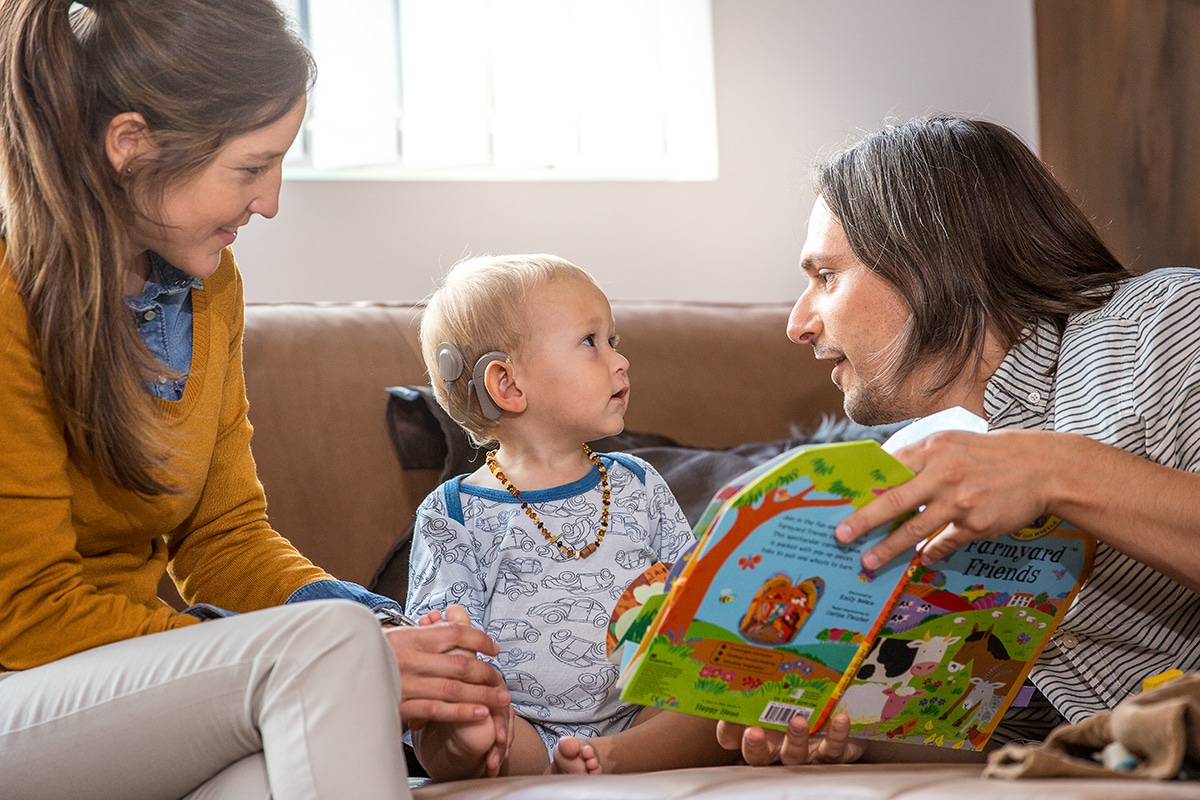
MED-EL
Published Apr 15, 2016
Help Your Child Develop Language Skills with Rhymes
Repetition is fantastic for children who are learning vocabulary. It might seem incredibly monotonous— maybe even boring—for parents, but this repetition helps your child develop many of their language skills.

Saying words or phrases once can help give your child an idea of what they mean, but it’s the natural repetition that will reinforce your child’s understanding of them.
And it goes way past just understanding what words mean.
Learning About Words
When we speak a word, we’re essentially joining together different speech sounds in different patterns. To start learning spoken language, a child needs to be able to hear and understand these sounds.
For a child with hearing loss, that often means using a hearing aid or hearing implant. But that’s not enough: they also need abundant and meaningful experiences that give them the chance to hear these sounds and patterns. Hearing these patterns over and over gives them the chance to recognise how spoken language is made up of these patterns joined together in different ways.
Rhyming is one way to help your child focus their attention on the different sound patterns we use in spoken language. This is because rhyming repeats and combines sounds in predictable ways.
When you say a rhyme to your child, you’re showing them similarities in specific sound patterns, and teaching them how different sounds can work together to sound similar.
- For example, the words “cat”, “rat” and “bat” all sound similar because they end with the same “-at” sound pattern. And, as they keep hearing new words through more rhyming activities, they’ll start to see that lots of other words can begin with different sounds but end with the same sound pattern: words that sound similar or rhyme, like “hat,” “sat,” or “mat.”
From Rhyming to Reading and Writing
Before a child can develop reading and writing skills, it’s important for them to have a good understanding of sounds and sound structures in spoken words. That’s because in developing these literacy skills, they’ll also use their phonological awareness skills: being aware of the sounds and sound structures of spoken words. When we read and write, we’re using our understanding of sounds and how sound patterns make words.
When your child hears rhymes through songs or reading, they’ll get more and more aware of all the sounds and sound patterns in the rhyme. And when they hear these over and over, your child will build their understanding of how the patterns are grouped together: the words’ phonological representation.
Later on, when they start to match letters to sounds, they’ll again use this knowledge, with their vocabulary and language skills, along with their vocabularies and language skills to support their development of their reading and writing skills.
Excitement and Emotion
When you sing, say a nursery rhyme, or read books that rhyme, you’ll probably mix up the speed and pitch of your voice depending on what’s being said.
- For example, take the sentence “His name is John.” And then take the question “His name is John?” You’re using the same words but, by changing the way that you use your voice, are showing that each has a different meaning or intent.
Varying your voice like this teaches your child that the way you say something can change its meaning. Changing the tone and loudness of our voice can also keep someone interested in what we’re saying. When your child begins to sing, recount past events, and read aloud, they’ll understand that changing up their voice to match the meaning of what they’re saying or reading can help in communicating their message to whoever is listening.
By varying your voice when singing or reading, you can also help your child to learn about emotion. By hearing you speak in different ways depending on what’s being said—Are you talking fast? Slow? Quiet? Loud? High? Low?—you’ll show your child how certain words imply certain emotional meaning.
Then, when your child will start to read and tell stories on their own, they’ll themselves start using similar animation and emotion to best express the story.
Check out these blog posts for tips about how you can use rhyming to help your child develop:
- Teach Language With Fingerplay, Rhymes, and Songs
- Tips for Reading Books With Your Child
- Using Routines to Build Language Skills
This post was written with help from Ingrid Steyns, a speech-language pathologist and rehabilitation manager at MED-EL.
References
-
[1]
Ambrose, S. E., Fey, M. E., & Eisenberg, L. S. (2012). Phonological awareness and print knowledge of preschool children with cochlear implants. Journal of Speech, Language, and Hearing Research, 55(3), 811-823.
-
[2]
DesJardin, J. L., Ambrose, S. E., & Eisenberg, L. S. (2009). Literacy skills in children with cochlear implants: The importance of early oral language and joint storybook reading. Journal of Deaf Studies and Deaf Education, 14(1), 22-43.
-
[3]
Lederberg, A. R., Schick, B., & Spencer, P. E. (2013). Language and literacy development of deaf and hard-of-hearing children: successes and challenges. Developmental psychology, 49(1), 15.
-
[4]
Spencer, L. J., & Tomblin, J. B. (2008). Evaluating phonological processing skills in children with prelingual deafness who use cochlear implants. Journal of Deaf Studies and Deaf Education, enn013.
References

MED-EL
Was this article helpful?
Thanks for your feedback.
Sign up for newsletter below for more.
Thanks for your feedback.
Please leave your message below.
Thanks for your message. We will reply as soon as possible.
Send us a message
Field is required
John Doe
Field is required
name@mail.com
Field is required
What do you think?
© MED-EL Medical Electronics. All rights reserved. The content on this website is for general informational purposes only and should not be taken as medical advice. Contact your doctor or hearing specialist to learn what type of hearing solution suits your specific needs. Not all products, features, or indications are approved in all countries.

MED-EL

MED-EL


